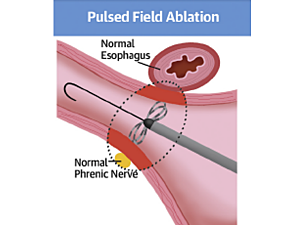Illustration of pulsed field ablation, modified from Reddy, V. Y., Neuzil, P., Koruth, J. S., Petru, J., Funosako, M., Cochet, H., … & Jais, P. (2019). Pulsed field ablation for pulmonary vein isolation in atrial fibrillation. Journal of the American College of Cardiology, 74(3), 315-326.
For patients with atrial fibrillation (AFib), catheter ablation using cold or heat has been the standard of care for about 20 years. Today, thanks to improvements in mapping and other technologies, this procedure is more effective and safer than ever.
While this technique has benefited many patients, further improvements are still needed. The procedure can take several hours, is associated with about a 2% complication rate, and requires adjunctive medications or a repeat procedure in approximately 15% to 20% of patients.
Clinical investigators at the Brigham and Women’s Hospital Cardiac Arrhythmia Service are participating in several clinical trials seeking to develop new, cutting-edge techniques with the potential to benefit more patients. The service, led by cardiologist and electrophysiologist William Henry Sauer, MD, is known worldwide for its expertise in evaluating and treating a wide range of abnormal heart rhythms affecting various patients, particularly those with complex medical concerns.
Dr. Sauer credits Jorge E. Romero, MD, who was recently recruited as director of Arrhythmia & Electrophysiology Research in the Division of Cardiovascular Medicine, for being instrumental in expanding the AFib research portfolio. Dr. Sauer adds that a team-based approach has meant that every member of the Cardiac Arrhythmia Service has contributed to the success of the research programs.
Using Pulsed Field Ablation for Pulmonary Vein Isolation
Among the trials currently active is the AdmIRE study, which uses pulsed field ablation for pulmonary vein isolation to treat people with symptomatic paroxysmal AFib. This technique incorporates high-voltage electricity to electroporate the cardiac muscle cells without requiring extreme temperatures.
“A lot of the complications associated with current ablation procedures are due to the effects of the heat or cold on adjacent structures,” Dr. Sauer says. “These procedures can sometimes cause injury to the esophagus or the phrenic nerve. But with pulsed field ablation, these structures are protected because they’re more resistant to that electroporation compared to the heart tissue.”
Since performing the first pulsed field ablation procedure at the Brigham in September 2022, the team has treated 20 more patients.
“My early experience with this technology is that the procedure is much faster. Patients feel great afterward, and they go home the same day without any problems,” Dr. Sauer says. “Although we have confirmed the procedure’s safety in the short term, more time is needed before we can determine its efficacy in the long term.”
Clinical Trials Offer New Approaches for Patients
Dr. Sauer and his team plan to participate in several other trials related to AFib. One of these, the ADVANTAGE AF Study, will explore the safety and effectiveness of an alternate pulsed field ablation system in patients with drug-resistant, symptomatic persistent AFib. Dr. Sauer expects that the trial will begin treating patients at the Brigham in December 2022.
Another study, the STAR AF3 trial, seeks to address a problem seen across all ablation techniques: The sites that are the source of AFib may be outside the areas around the pulmonary veins that are usually the target of ablation. This trial will evaluate a mapping technique to identify the appropriate areas to be ablated.
Mapping technology is important because it allows physicians to detect repeating patterns by analyzing electrocardiogram data. “These systems guide us toward those patterns that may be causing atrial fibrillation,” Dr. Sauer says. “What all of this research has in common is that it’s focused on leveraging different types of new technology.”
Cardiac Arrhythmia Service Moves the Field Forward
Collaboration is vital across the Cardiac Arrhythmia Service. The service includes a diverse team of specialists with expertise in all areas of cardiac care, including cardiologists, surgeons, inpatient and outpatient care teams, technicians, and nurses. Patients, including those with underlying medical conditions, can benefit significantly from the range of expertise.
“In addition to receiving treatments that have the potential to improve outcomes and are not yet available elsewhere, patients who participate in clinical research at the Brigham make important contributions to science and move our field forward,” Dr. Sauer says. “We are grateful to them for that.”
